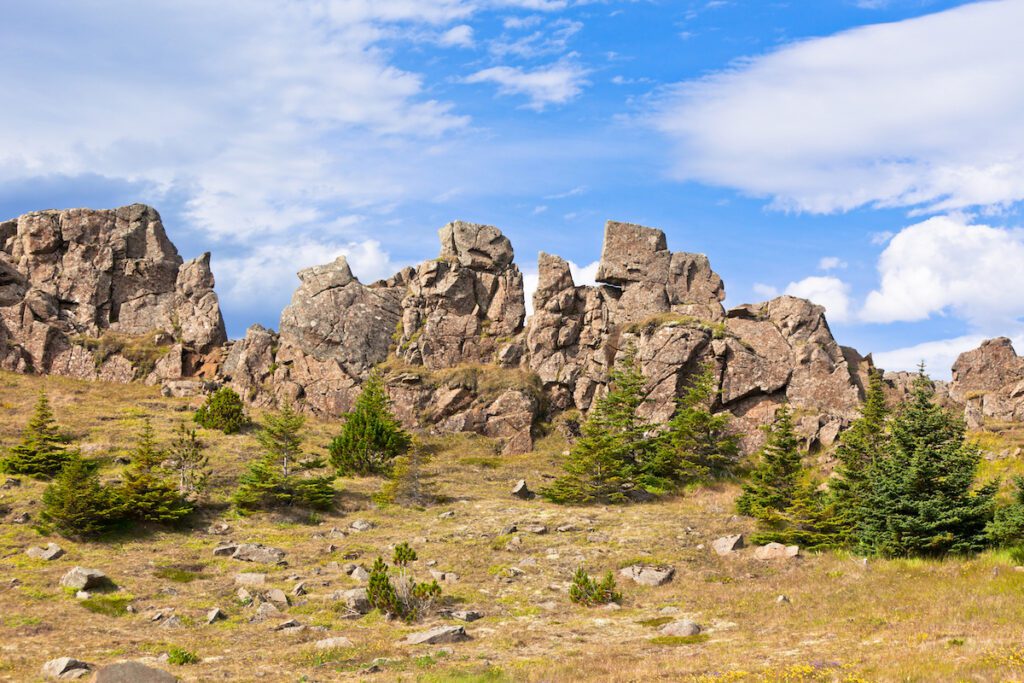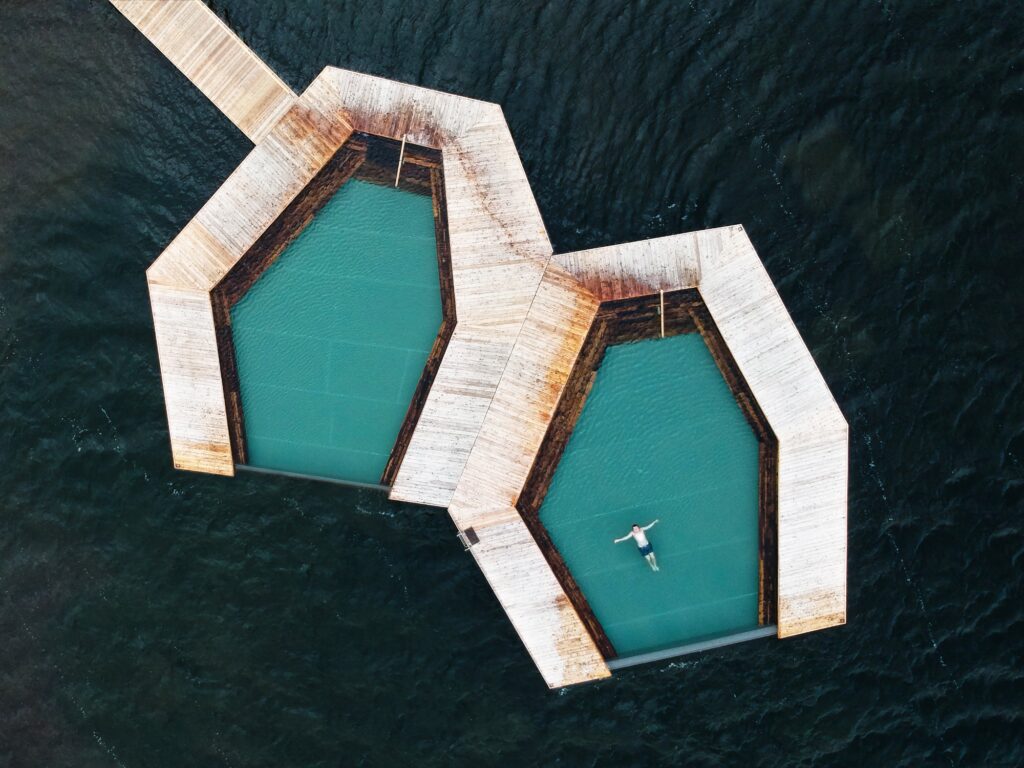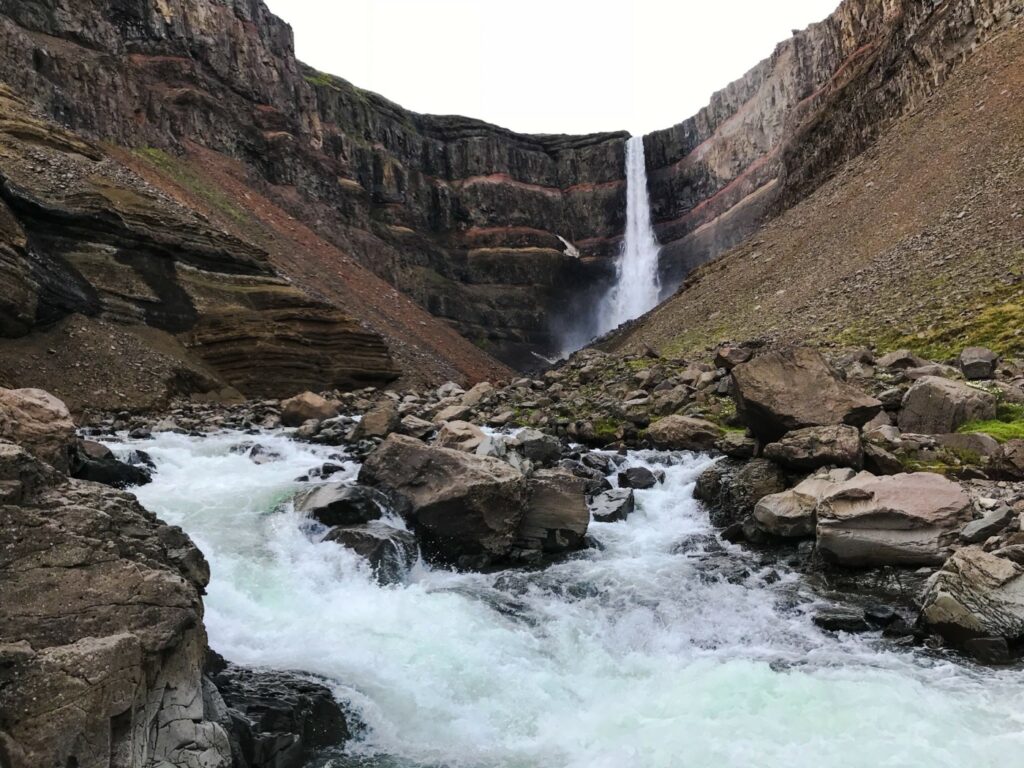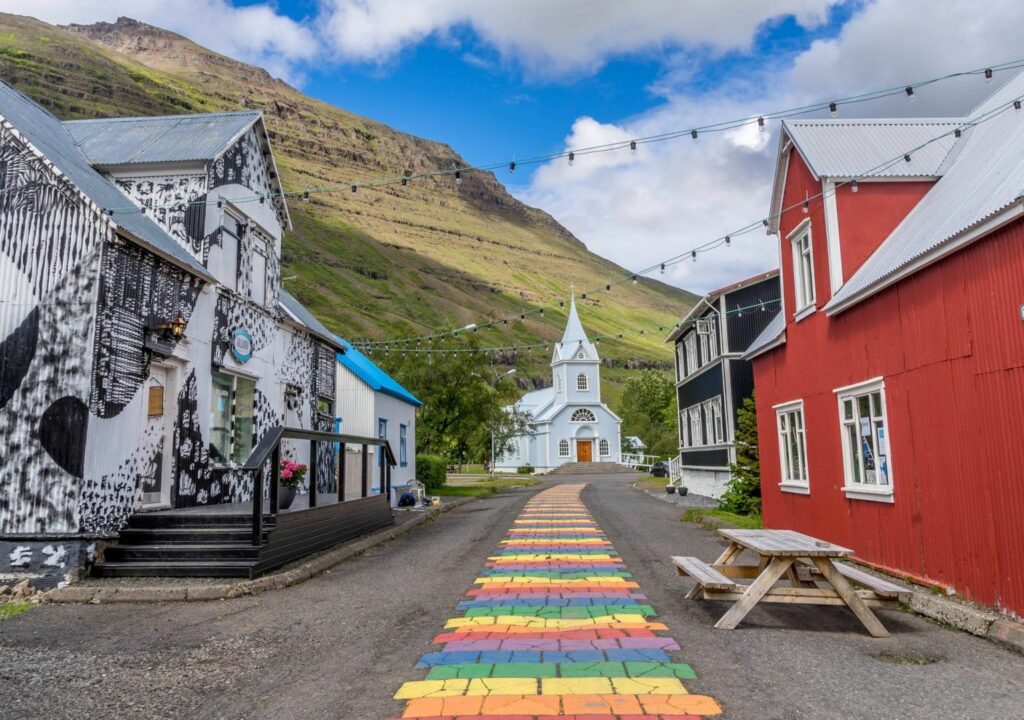Whether you are a seasoned traveler, an adventurous family, or a first-time solo traveler looking for a memorable road trip, Iceland is the perfect destination. The scenery is stunning, the locals are friendly, and there is a lot of adventure and fantastic tourism scenes across the country. You should consider touring Iceland at least once in your life. To be honest, resisting a tour every holiday will be hard.
One of the least visited regions is East Iceland. This region is also referred to as East Fjords. However, what the region lacks in visitors and resident numbers, it makes up for with its natural beauty and tranquility. Driving along the east coast will leave you with indelible memories as you take in the dramatic scenery of the steep sea cliffs, snowy peaks, and small fishing villages characterized by colorful old houses.
The history and culture of East Iceland is varied. It ranges from the French heritage in Fáskrúðsfjörður to the Norwegian architecture of Seyðisfjörður. You will also get the chance to take in the WWII history of Reyðarfjörður and learn about mythical sea creatures. Simply put, East Iceland is a destination that will give you alien experiences.

When to Visit
The best time to visit Iceland will depend on what you are interested in. Spring starts in April and May. This is the best time for outdoor activities. The summer months are from June to August. This is the peak tourist season in Iceland. It is also the best time for hiking. Being the busiest period, summer is the most expensive time to visit Iceland. Make sure you book your accommodation and flights early.
While summer is the best time to visit East Iceland, there is a lot to see and experience in winter. This is more so if you want to catch a glimpse of the breathtaking northern lights. Winter starts from October to September. All the same, it is still possible to enjoy a drive around the Ring Road in winter. Mid-winter is the worst time to travel because you will be limited on where to travel because of the snow. All the same, mid-winter is the best time to experience the Northern Lights.
Top Places to See in East Iceland
Even in peak tourist season, East Iceland offers a less hectic experience. Covering a huge expanse of 22,721 square kilometers, the region is home to about 16,000 people. This means the region has little human destruction. It is one of the best places in the world to experience nature at its best. Here are some of the best places to see.
Lagarfljot
Also known as Lögurinn, this is a 53-square-kilometer lake found near Egilsstaðir. It is a popular destination in East Iceland. The local myth is that the lake is home to Lagarfljótsormurinn, a cryptid, serpent-like creature. The monster is believed to live in the depth of the lake and makes an appearance every few decades. It is thought to be the cause of the low population in the region because the creature destroys farms, hunts villagers, and shoots poison when it appears. The first sighting was in the 14th century, and the creature was spotted fourteen times in the 17th century. In 2012, a purported video of the creature was recorded and posted on YouTube (The Iceland Worm Monster). Is the creature real or myth? There’s only one way to find out.
Viti Crater Lake
This lake is found in Askja caldera. It is a 50 square kilometer depression that formed in the last glacial age. It was formed when a chamber in the Dyngjufjöll mountains collapsed. Currently, the lake has a depth of 700 feet. This makes it the second deepest inland lake in Iceland. The lake is continually warm, something that has caused scientists to believe there is geothermal activity in the area and there might be an upcoming eruption. To get to the lake, you have to hike for about an hour across the Askja black sand dunes. At the top, you will be stunned by how majestic the lake is. You also get to take in the amazing architecture of the crater edge. The lake is suitable for swimming.
Hengifoss waterfall and Litlanesfoss waterfall
The Hengifoss waterfall is 128 meters high in the Fljótsdalshreppur municipality and next to the Lagarfljót Lake. It is the highest waterfall in Iceland. It is known for its red and black basalt rock wall, which sits behind the falling water. Bring comfortable walking boots because the parking is 2.5 kilometers from the waterfall. The hike to the waterfall takes about an hour.
The Litlanesfoss waterfall (35 meters high) is a short distance away from the Hengifoss waterfall. The waterfall is known for the hexagonal basalt columns which surround the waterfall. If you are a nature enthusiast, you can see both waterfalls on a hike along the Hengifossa river.
 Hallormsstadaskogur National Forest
Hallormsstadaskogur National Forest
Ever heard of the Icelandic joke – how do you find your way out of an Icelandic forest? Just stand up! This joke is factual because Iceland is heavily deforested. This happened during the settlement period when the timer was used for virtually everything. The subsequent soil erosion worsened the issue. With most of the region being bare, the Hallormsstadaskogur National Forest has been granted government protection. The trees cover 550 hectares, and the forest is home to more than 85 different species. The forest is home to Iceland’s birdlife.

Storurd
The Stórurð (“The Giant Boulders”) is located at the base of the Dyrfjöll mountain. The area is known for enormous natural rock sculptures that decorate the scene. This makes the region a hiking paradise thanks to its unearthly terrain.
Petra’s Stone Collection in Stöðvarfjörður
If you know the history of Ljósbjörg Petra María, you will want to visit the Petra stone collection. Ljósbjörg Petra María was born in 1922 in a small village called Stöðvarfjörður. She faced many challenges in her early life. She was fascinated with the natural world, which defined her adult life. Given that “Petra” is Greek for “Stone,” it seems Petra was destined to dedicate her life to the study of rocks and minerals. She sought out the most exquisite geological rock samples; her house was not enough to house all of them. In the 50s, she began decorating her garden with the rocks, which quickly attracted passing travelers. The house eventually turned into a natural history museum. Petra’s home is also now the home to Café Sunnó, which is open from 1st June to 1st September from 10:00 to 17:00 every year. It offers coffee, tea, cookies, and sandwiches. Petra passed away in 2012.
Bulandstindur Mountain
Búlandstindur is a pyramid-shaped mountain, just like the Snæfellsjökull, in the West of Iceland. Many in Iceland consider Búlandstindur to be the country’s energy source, and it has inspired poets, mystics, and artists for centuries. The distinctive shape of the mountain originates from the visible layers of basaltic strata, which were sculpted and formed for millions of years. Búlandstindur, also called Goðaborð (God’s Rock), gets its name from an event that took place following the Christianization of Iceland in 1000 AD, where Iceland’s chiefs climbed the mountain and threw pagan idols from it to demonstrate their servitude to the new deity. The same event also took place at the Goðafoss waterfall in northeast Iceland, where Þorgeir Ljósvetningagoði, the law speaker, threw his idols into the tumultuous water. If you are into hiking, you are in luck, as Búlandstindur has a number of walking trails of varying difficulty, all of which lead to the mountaintop. The views from the top (which peaks at 1069 meters) are otherworldly, spanning several fjords.
You can get a great view of Búlandstindur from Djúpivogur, a nearby village. Djúpivogur, which was founded as a Danish trading post in the 19th century, has a fascinating history, including being a port of call for Hans Jonatan, an escaped slave and one of the first people of color in Iceland. The village has about 500 inhabitants today and is best known for Eggin í Gleðivík (The Eggs of Merry Bay), an art exhibition of 34 large eggs by Sigurður Guðmundsson, an Icelandic photographer.
Laugarvellir Hot Natural Waterfall
Iceland is known for its geothermal pools. Laugarvellir is one such remote geothermal pool in Iceland’s Central Highlands. The geothermal pool has the perfect temperature for a nice soak at between 39 and 41 degrees Celsius. You should, however, always check the temperature with your fingertip before jumping in. The geothermal pool is located 600 meters into the Highlands and is surrounded by lush vegetation. An interesting fact about the area is that despite the region’s fertility, the soil is extremely difficult to cultivate, and there are abandoned buildings that were left behind by disillusioned farmers to prove this. The fact that Laugarvellir is hard to access (it is only accessible during summertime) is a blessing in disguise as it means fewer visitors and consequently little distraction of nature. You need a 4×4 vehicle to make it up the gravel roads and then walk about 7 kilometers from Hálslón Dam.
Vatnajokull National Park
The Vatnajökull National Park covers 13,900 square kilometers or 14% of Iceland. It is difficult to miss on your drive toward the Eastern or Southeastern parts of the country. The park was opened in 2008, merging the Vatnajökull glacier with the smaller Jökulsárgljúfur and Skaftafell National Parks. Vatnajökull is by far the largest icecap outside of the earth’s poles, standing at 8,100 square kilometers. Beneath the ice, there are subterranean lakes and crevasses, valleys, and even mountain peaks, including Hvannadalshnúkur, the highest mountain in the country. From the ice cap comes over 30 outlet glaciers, many of which can be seen from the Ring Road. The most famous of these are Breiðamerkurjökull and Skaftafellsjökull.
Vestrahorn Mountain
Vestrahorn is considered by many to be one of the most beautiful mountain capes in Iceland. Vestrahorn mountain is 454 m/1450 feet high and is between 8 and 10 million years old. It was home to Irish monks before they were enslaved by the Norse. This is one of the few Gabbro mountains in Iceland. This means it was formed by hot magma that was trapped beneath the earth and slowly cooled over time, forming a holocrystalline mass. Vestrahorn is located 12 kilometers (7.4 miles) east of Höfn. With its rugged, sharp peaks on the backdrop of the surrounding blue ocean and its rolling tundra, the mountain is a place of dream-like surrealism that has endeared photographers and nature lovers for years. If you are thinking of having a swim on the coastline, you should be aware that the beach experiences sudden, unpredictable waves that flow higher into the tide than is normal, the underlying currents are strong, and the temperature is cold, so you should be careful.
Visit a Viking Village Replication on the Stokksnes Peninsula
There is an access fee when visiting the beach on the Stokksnes Peninsula, but it is 100% worth it. This access fee includes entry to a Viking village replication on the Peninsula, and you should take advantage of this. It is a unique feature in the region. The village was built for a movie that never got into production in 2010 and is open to exploration in full. There are cute Icelandic horses and sheep on your way to the village, which is fenced all around and includes glass-covered wooden buildings.
The Red Chair Art Installation
This East Iceland feature is certainly unique. It lies on the Ring Road between Egilsstadir and Hofn on an empty landscape. The Red Chair art installation is a puzzling art installation that will draw your eyes with its obscure presence and bright color. You can sit on the oversized chair and have pictures of you taken. The chair is set on a large rock that is surrounded by moss. Making this stop also allows you to stretch your legs.
Stop and take a picture of you while sitting on this huge chair. It is fastened onto a large boulder with moss all around. Save it as a memory or send it to your friends back home and see how they react.
Photograph the Hvalnes Lighthouse
Hvalnes Lighthouse attracts photographers and travelers to the region. The lighthouse, which stands at 38 feet, is brightly colored (orange) with a funky shape. It was built in 1954 and is operational to date, standing guard over the Hvalnes Nature Reserve beaches. Although you are not allowed a visit to the inside since it is still in use, it is still a worthy stop on your Ring Road drive because it is near the road, and a stop only takes a few minutes. Take a few photos before proceeding to your next stopover.
Visit a Beach on the Laekjavik Coast
The Laekjavik Coast is located between Djupivogur and Hofn. The coast has many black sand beaches that do not have as many visitors as the more famous beaches in Iceland. Even though you can see the cool beaches from the Ring Road, most of them are hidden gems. You can walk along the beaches and enjoy the powerful waves and the rock formations. However, you should remember that due to the powerful waves, it is not advisable to swim.
Hike the Studlagil Canyon
Studlagil Canyon is considered by many to be the best canyon in Iceland. The canyon lies between black basalt cliffs on either side and is filled with bright blue glacial water, making for jaw-dropping scenery. It takes just under 6 hours to go around the canyon, meaning this hike is not for the light-hearted. Most of the trails are not properly maintained, but you can find your way through with appropriate shoes and if you take due care to avoid slip and fall accidents. While at it, visit the beautiful Studlafoss waterfall located along the way.
A Romantic Soak in the Djupavogskorin Hot Spring
No trip to Iceland is complete without dipping in one of the many natural hot springs. One of these along the Ring Road is the Djupavogskorin Hot Spring. The small spring is the size of 2 bathtubs, making it ideal for a soak by a romantic couple. The spring is hidden from the main road by hills, meaning you will have some privacy. You will enjoy the peace and quiet and wonderful views of nature. Like with other hot springs in the country, you are responsible for cleaning up after yourself.
Seydisfjordur Town
The town of Seydisfjordur is full of charm. There are many brightly colored buildings here, with the most photographed being the bright blue and white church. The road has a rainbow painted on it, guiding visitors to the church. Other than the church and the charming buildings, there is also a ski area nearby where you can ski in the winter months and a golf course where you can enjoy a round in the summer months. There is also a lighthouse, museums, and hiking trails that lead you to amazing mountain views and waterfalls. This fishing village was once a hidden gem but has been popularized by social media. It is located just 30 minutes from Ring Road. There are several places where you can eat and sleep before you continue with your journey.
Mjoifjordur Fjord
Mjoifjordur, which translates to the “Narrow Fjord,” is located in an area famous for its calm weather and beauty. This fjord, and the small town that bears the same name, make for great spots for those who want to see Iceland off the beaten path. You can enjoy a scenic hike where you get to see remote waterfalls all by yourself. If you are into lighthouses, the Dalatangi Lighthouse, which is painted bright orange, stands out against the landscape. Another unique thing to find on Mjoifjordur is the wreck of a World War II U.S. Navy ship. The rusty ship skeleton is surrounded by moody mountains and water and is every photographer’s dream.
Spot Puffins at Borgarfjardarhofn
Iceland is known for its big population of Puffins. In East Iceland, you can spot the unique birds at Borgarfjardarhofn. Thousands of puffins flock to Borgarfjardarhofn to nest each year in the summer. This is a safe and laid-back place to watch the creatures from mid-April to mid-August. There are wooden platforms and shelters where you can bird-watch without fear of falling off the cliffs or damaging burrows allowing you to get as close to the puffins as possible. Other than puffins, you can also catch a glimpse of kittiwake, fulmar, and common eider, among other bird species.
Vök Baths
You have not really experienced Iceland if you have not been to one of the world-famous baths. Vök Baths are the largest sauna and spa in East Iceland. The baths, located on the edge of Lake Urriðavatn, are popular because of the facilities on offer, including changing facilities, a place to rent swimsuits, and showers. It consists of an open bath on the edge of Lake Urriðavatn and two huge pools inside the lake that are accessible through a cold tunnel. There is a fabulous pool bar in one of the pools where you can take tisane tea made from authentic Icelandic ingredients like herbs. Unlike the natural baths that make use of hot water that contains minerals like silica and which can have an egg-like smell that can be off-putting to many, the water in Vök is naturally heated and contains no minerals, meaning there is no eggy smell. So if your visit to the Blue Lagoon didn’t do it for you, Vök Baths are a must-visit. Note that the water from Lake Urriðavatn comes from a spring and flows through the bath, so the water does not gather and stay. The water is even drinkable. There are different types of tickets available, and there is a premium restaurant where you can take a drink or a scrumptious dish and relax.

There is a lot more to see in this region. However, to explore the hidden gems of East Iceland, you should add a few extra days to your self-drive tour. If driving around the Ring Road is not appealing, there are guided small group tours available. Guided tours help you learn more about the region, and you get the best experience thanks to the guidance of a local who knows where all the best places are. Deluxe Iceland offers some of the best luxury tours in the country.

 Hallormsstadaskogur National Forest
Hallormsstadaskogur National Forest
